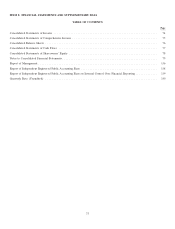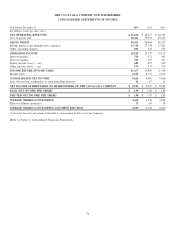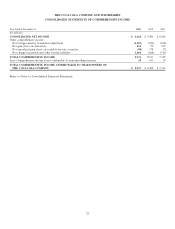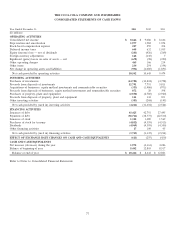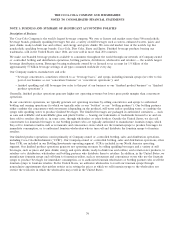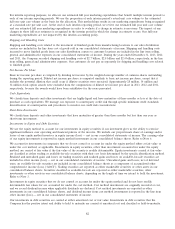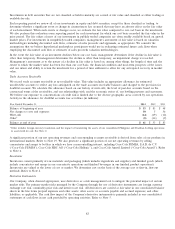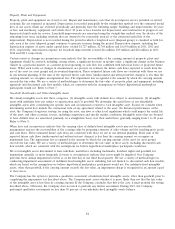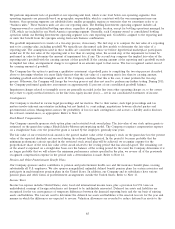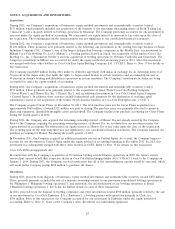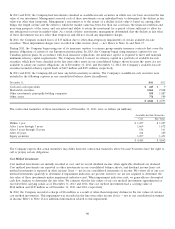Coca Cola 2013 Annual Report Download - page 84
Download and view the complete annual report
Please find page 84 of the 2013 Coca Cola annual report below. You can navigate through the pages in the report by either clicking on the pages listed below, or by using the keyword search tool below to find specific information within the annual report.For interim reporting purposes, we allocate our estimated full year marketing expenditures that benefit multiple interim periods to
each of our interim reporting periods. We use the proportion of each interim period’s actual unit case volume to the estimated
full year unit case volume as the basis for the allocation. This methodology results in our marketing expenditures being recognized
at a standard rate per unit case. At the end of each interim reporting period, we review our estimated full year unit case volume
and our estimated full year marketing expenditures in order to evaluate if a change in estimate is necessary. The impact of any
changes in these full year estimates is recognized in the interim period in which the change in estimate occurs. Our full year
marketing expenditures are not impacted by this interim accounting policy.
Shipping and Handling Costs
Shipping and handling costs related to the movement of finished goods from manufacturing locations to our sales distribution
centers are included in the line item cost of goods sold in our consolidated statements of income. Shipping and handling costs
incurred to move finished goods from our sales distribution centers to customer locations are included in the line item selling,
general and administrative expenses in our consolidated statements of income. During the years ended December 31, 2013, 2012
and 2011, the Company recorded shipping and handling costs of $2.7 billion, $2.8 billion and $2.4 billion, respectively, in the line
item selling, general and administrative expenses. Our customers do not pay us separately for shipping and handling costs related
to finished goods.
Net Income Per Share
Basic net income per share is computed by dividing net income by the weighted-average number of common shares outstanding
during the reporting period. Diluted net income per share is computed similarly to basic net income per share, except that it
includes the potential dilution that could occur if dilutive securities were exercised. Approximately 28 million, 34 million and
32 million stock option awards were excluded from the computations of diluted net income per share in 2013, 2012 and 2011,
respectively, because the awards would have been antidilutive for the years presented.
Cash Equivalents
We classify time deposits and other investments that are highly liquid and have maturities of three months or less at the date of
purchase as cash equivalents. We manage our exposure to counterparty credit risk through specific minimum credit standards,
diversification of counterparties and procedures to monitor our credit risk concentrations.
Short-Term Investments
We classify time deposits and other investments that have maturities of greater than three months but less than one year as
short-term investments.
Investments in Equity and Debt Securities
We use the equity method to account for our investments in equity securities if our investment gives us the ability to exercise
significant influence over operating and financial policies of the investee. We include our proportionate share of earnings and/or
losses of our equity method investees in equity income (loss) — net in our consolidated statements of income. The carrying value
of our equity investments is reported in equity method investments in our consolidated balance sheets. Refer to Note 6.
We account for investments in companies that we do not control or account for under the equity method either at fair value or
under the cost method, as applicable. Investments in equity securities, other than investments accounted for under the equity
method, are carried at fair value if the fair value of the security is readily determinable. Equity investments carried at fair value
are classified as either trading or available-for-sale securities with their cost basis determined by the specific identification method.
Realized and unrealized gains and losses on trading securities and realized gains and losses on available-for-sale securities are
included in other income (loss) — net in our consolidated statements of income. Unrealized gains and losses, net of deferred
taxes, on available-for-sale securities are included in our consolidated balance sheets as a component of accumulated other
comprehensive income (loss) (‘‘AOCI’’). Trading securities are reported as either marketable securities or other assets in our
consolidated balance sheets. Securities classified as available-for-sale are reported as either marketable securities, other
investments or other assets in our consolidated balance sheets, depending on the length of time we intend to hold the investment.
Refer to Note 3.
Investments in equity securities that we do not control or account for under the equity method and do not have readily
determinable fair values for are accounted for under the cost method. Cost method investments are originally recorded at cost,
and we record dividend income when applicable dividends are declared. Cost method investments are reported as other
investments in our consolidated balance sheets, and dividend income from cost method investments is reported in the line item
other income (loss) — net in our consolidated statements of income.
Our investments in debt securities are carried at either amortized cost or fair value. Investments in debt securities that the
Company has the positive intent and ability to hold to maturity are carried at amortized cost and classified as held-to-maturity.
82



